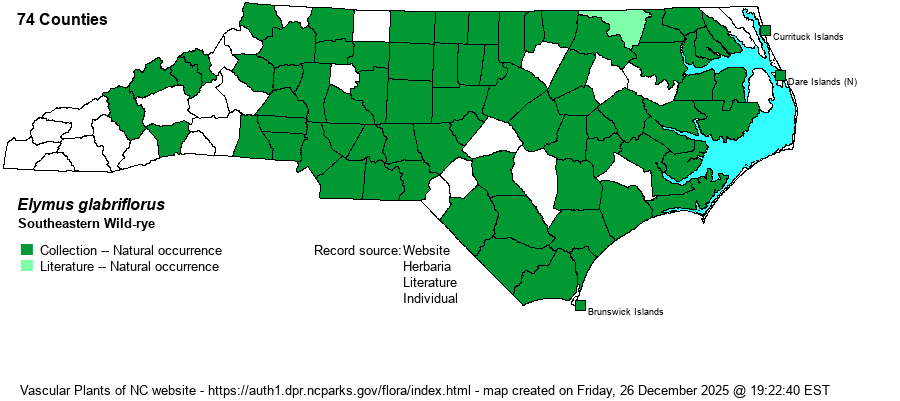| Author | (Vasey ex L.H. Dewey) Scribner & Ball | |
| Distribution | Throughout the state, but apparently infrequent in the Mountains. Most records in NC were formerly determined as E. virginicus. The map below reflects specimens annotated by Julian Campbell who monographed the genus recently.
Southern VA to KS, south to northern FL and TX. | |
| Abundance | Fairly common to common in most of the state, but uncommon in the Mountains. | |
| Habitat | Moist to seasonally wet or seasonally flooded floodplains, bottomlands, and swamps; wet ditches and roadsides through such habitats; sometimes in moist to mesic lower slopes away from rivers. | |
| Phenology | Flowering and fruiting July-September. | |
| Identification | This is a wild-rye of average height and dimensions. It has recently been split off from E. virginicus. From E. virginicus, it is told by wider inflorescences (including the awns, from 2.2-4.5 cm wide vs. 0.7-2.2 cm wide in E. virginicus) and glume awns that are 10-30 mm long (vs. 0-10 mm long). | |
| Taxonomic Comments | See Weakley (2020) and FNA for a description and range map. This species was resurrected by J.J.N. Campbell in 2000, so botanists are now figuring out the relative frequency of it vs. E. virginicus. Weakley (2020) recognizes 2 varieties, one more eastern and one more western in NC; we await annotated specimens before attempting to map each separately.
Ryegrasses or Wild-ryes (genus Elymus) are noted by their evenly spaced leaves and elongate, terminal inflorescence that recall cultivated rye or wheat. Each floret produces several long, skinny awns (shortest in E. virginicus sensu stricto). Identification of some species requires a dissecting scope or at least a 10x handlens. | |
| Other Common Name(s) | None | |
| State Rank | S4? [S5] | |
| Global Rank | G5 | |
| State Status | | |
| US Status | | |
| USACE-agcp | | |
| USACE-emp | | |

